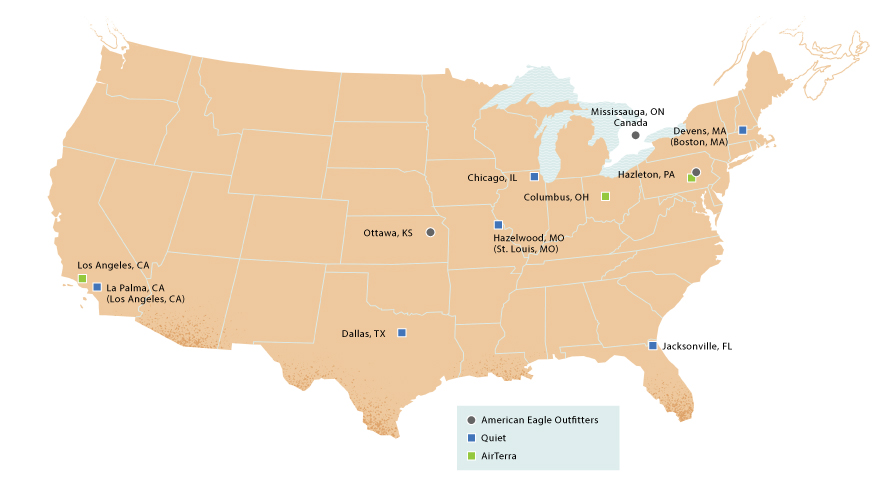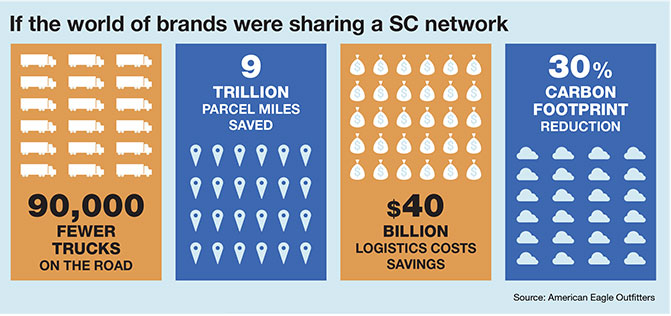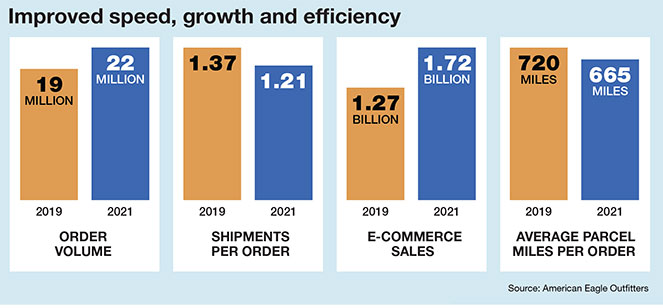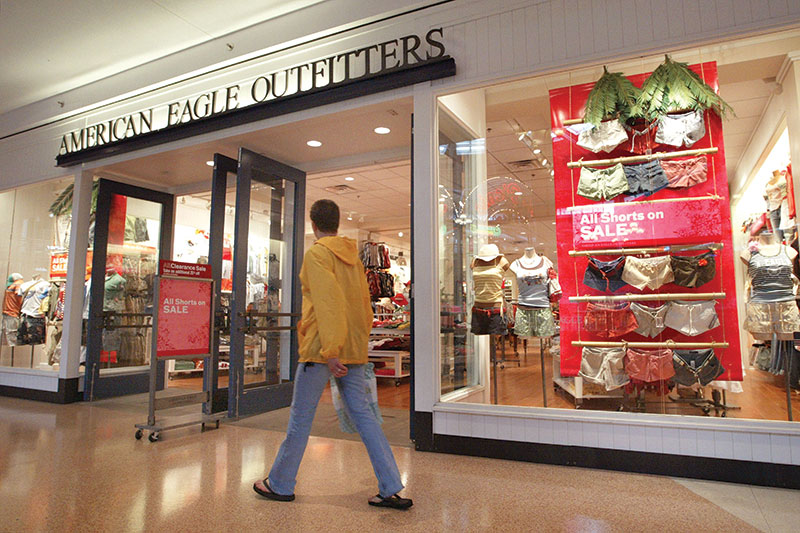American Eagle Outfitters’ outside fulfillment game strategy
American Eagle Outfitters has long been a leader in e-fulfillment inside its distribution centers. The next step: Move outside the four walls with a distributed fulfillment network that is shared by other like-minded retailers to compete with the big guys.
Editor’s note: This is the second of a two-part series on American Eagle Outfitters’ (AEO Inc.) new approach to retail and e-tail fulfillment. Part 1 looked at AEO’s facilities; in Part 2 we look at its shared network.
Many of us think of e-fulfillment as an inside game. The focus is on having the right assortment of inventory in a facility, complemented by highly automated systems and robotics that can process orders at record speeds and on the fly.
But what’s also becoming increasingly clear is that it’s possible to win at the inside game and still lose the customer service battle as next-day delivery becomes table stakes, with a push toward more same-day capabilities for urban fulfillment.
You can’t do that without an outside game, one that moves SKUs with high affinity and velocity to the edge where your customers reside. After all, what have you really accomplished if you can pick and pack an order in 10 minutes but can’t meet the new delivery expectations because of geography?
That concept was behind the build out of Amazon’s network. It’s now the challenge for the small to mid-sized retailers that populate our malls, shopping centers and Main streets, yet don’t have the scale or financial wherewithal of Amazon, Walmart or Target. Like American Eagle Outfitters.
Ship-from-store is one solution, since the inventory is already close to the customer; however, ship-from-store is as costly as it is inefficient. It’s a solution, but not the most efficient solution. Perhaps there’s a better way?
Perhaps, through the sharing of supply chain assets and resources in a distributed network, like-sized, like-minded retailers can share the cost and gain the ability to better compete and keep pace with retail giants within key markets.
That is the beyond the outside game thinking Shekar Natarajan, AEO’s executive vice president and chief supply chain officer, has had in the works for the past five years, which he coins Supply Chain 4.0. Natarajan, who also runs Quiet Platforms, a new entity created following AEO’s 2021 acquisitions of AirTerra and Quiet Logistics, is well aware of the potential challenges ahead in convincing new retailers to participate in this platform. But the concept seems to be working thus far. It represents an entirely new way of thinking about logistics, one that may deliver the kind of shareholder value to AEO that is often lacking when it comes to supply chains, which are traditionally viewed as a cost center.

As Natarajan puts it: “In retail, we all have to offer the same level of personalized service to the customer, regardless of whether we are Walmart or AEO. But, there are no shared solutions.” He adds that “nearly every network in the world, from Uber to Airbnb to Cloud computing, has gone to a distributed model except for logistics, where we still think we need to control it all.” When you factor in customer service demands with labor, warehouse and transportation constraints, perhaps the time is right for a shared, distributed model in e-fulfillment.
Supply Chain 4.0
Before we look at AEO’s strategy, let’s start with a definition: Just what is Supply Chain 4.0?
Natarajan says that it’s based on a very simple premise: The world of retail is bifurcated into Davids and Goliaths. Goliaths have scale, size and the value they have created for themselves. The Davids have a slingshot.
“Between 2020 and 2022, Apple, Amazon and Walmart together created $2.5 trillion in value,” Natarajan says. “If you take out the digitally native guys and their marketplaces, like Etsy, Ebay and Wayfair, the other companies together created $120 billion in value.”
The only way the Davids can get the size and scale they need to compete is to aggregate their volume and share the network. He describes it as “an on-demand, hyper-scalable, consumer-centric ecosystem of networks; one that, like AWS, surges as demand increases and can be plugged into just as apps plug into Android or iOS.” Most importantly, it’s a shared environment that aggregates volume for fulfillment and delivery, and that is self-learning, cognitive and laser-focused on optimization.

“It’s a co-opetition/frenemy model,” says Natarajan, a term he uses to describe an environment where retailers compete on product and price, while the collaborative platform gives the supply chain process scale, control and leverage.
They do so with a network of strategically located fulfillment and transportation induction points, smart sortation models, optimization technologies and hyper-connected algorithmic protocols that allow participants to aggregate their orders to get closer to the market and ship smarter. And while large players could participate, the idea is to create a network for the small to mid-sized retailers like AEO with say $5 billion or less in annual sales.
“Right now, individual retailers don’t have a lot of leverage,” says Natarajan. “Through a shared network, you have volume and leverage because you’re going to the carriers as a collective.”
He adds that “it allows brands to focus their resources on brand-related activities like marketing and product development and fulfillment becomes operations-as-a-platform or operations-as-a-service.”
You might wonder why Natarajan feels this is a necessity to address. In part, he notes, it’s due to the growth of e-commerce as it relates to population growth. “The United States population is growing at 0.1% while e-commerce is growing at 10% to 15% year over year, and e-commerce is a lot more asset and resource intensive. When you consider inflation today, our actions as retailers are only adding fuel to the fire.”
As an example, he points out that when Company A decides to build a new industrial campus and pay associates $20 an hour, everyone in that market is forced to follow suit. “At the end of the day,” he says, “the cost of business has to go up, which translates to higher prices for everyone.
Natarajan contends that if every brand shared its capacity and retail networks were interoperable, we could take 90,000 trucks off the road, travel 9 trillion fewer parcel miles, reduce the carbon footprint by 30% and realize $40 billion in annual logistics costs savings. “That’s the power of sharing and the openness of the network,” he says.
Dealing with scarcity
Supply Chain 4.0 sounds like a big, complex idea. However, Natarajan says that the premise was shaped by an impoverished childhood in India. “I’m very proud to say that I came from the slums of India, where access to education, access to electricity, or access to pay for a funeral or a marriage was a big deal,” he says. “I can remember reading by kerosene lamps when I was in the 10th grade because we didn’t always have electricity. That was in the 1990s.”
Scarcity and limitation in access forced individuals to share to save money. One of Natarajan’s favorite images is a drawing of a host of people riding on a rickety-looking vehicle, some standing on the outside running boards.
“This is how people in India travel all the time because it’s only 5 rupees to get from Point A to Point B,” he says. “It’s understood that having 10 people who are likely complete strangers on the vehicle means everyone can get to their destination with a cheaper ride.” Natarajan likens the vehicle, known as an auto rickshaw, to Uber without the technology.
Scarcity and abundance have defined supply chain designs for years. In Europe, distribution centers are tall to reduce the need for land and highly automated to reduce the reliance on labor, which have both long been expensive and scarce. In the United States, until recently we built sprawling and manual DCs because land and labor were abundant and affordable. Now, the demands on both land and labor due to the increase in e-commerce are changing that equation.
“Logistics used to be a buyer’s market,” Natarajan says. “Now, it’s a seller’s market.” That’s going to continue as long as demand continues to outstrip capacity.
Yet, most retailers continue building their own networks because they believe they need to control the customer experience. But if you take a step back and really think about it, Natarajan notes, in most cases, supply chains’ many linkages fall outside of an individual retailer’s realm of control.
“You don’t control your supplier’s factory. You don’t control the consolidator. You don’t control the ship or the port. And you don’t control the transloader, the mode of transportation, nor can you control UPS, FedEx or the post office,” he says. “Even if you own a DC, you don’t control the temp agency you rely on at peak. So, where is the control?” To further complicate matters, retailers are all locating their facilities in the same logistics hubs to be close to carriers, driving up the cost of land and wages.
And then, there is the continued growth and scale of the Goliaths. “What AEO does in a year, Walmart does in a day and a half and Amazon does in half a day,” Natarajan says. In fact, it would take 250 AEOs to get to Walmart’s scale, which enables them to create private networks. “Despite how much the Davids put assets and resources on the ground, the fact of the matter is they’re unlikely to ever catch up,” Natarajan says.
Shared networks are already common in other industries. Think Uber, Airbnb, Spotify and AWS. “In the B2B world, we realize that you don’t need a car, you need a ride,” says Natarajan. “You don’t need a hotel, you need a stay; and you don’t need a computer under your desk, you just need a connection to the Cloud. Supply chain needs to take the lessons on sharing from a developing country, which is where I come from.”
Think of it as the Uberization of supply chain, where every step of the workflow is open and shared.
Going outside at AEO
While Natarajan was thinking of a way to “Uberize” supply chain before he joined AEO, his marching orders were less expansive: First, he was tasked with rethinking processes because AEO was at an inflection point where capacity was constrained by demand.
“It was a pivotal moment for the company, where we had to ask whether we were going to build another distribution center for $250 million, or use this as an opportunity to rethink our distribution architecture in a different way,” Natarajan says. Second, he was advised “to not screw things up.”
To the second task, AEO was already ahead of many of its competitors on its inside game. Continuous improvement was a best practice. So, during 2019, Natarajan’s first full year on the job, the focus shifted to the outside game. “The mantra was speed, speed, speed,” Natarajan recalls. “We looked at every workflow and asked: Where are we dwelling, why are we dwelling, and what can we do to get it tighter?”
For instance, when he joined the organization, a process known as Super Air Direct could get product from Asia into a United States-based store in four days. That was great, but air is expensive, and conventional ocean shipments took an average of 14 days. Natarajan asked what would it take to shorten that time to five days? “We were trying to achieve a cultural shift to looking at the operations through metrics, data and insights,” he says.
Harnessing the Association of Supply Chain Management’s SCOR model, Natarajan and his team became hyper-precise with inventory allocation. “We introduced new, multi-modal ways to bring product into the country, using a combination of air and ocean instead of the traditional single mode to achieve faster inventory productivity,” he says.

Their efforts weren’t limited to inbound logistics, but also to establishing a regionalized carrier base to match the localized nature of their network and the growing need for proximity to the end consumer.
Speed was accomplished through pure process rigor of doing things better and faster, and by looking for innovations in how contracts were constructed and relationships were managed. One example was to work with FedEx to redesign how stores were replenished.
Traditionally, AEO replenished stores with a large shipment once or twice a week; however, given the time that it took to get point of sale data from the stores, allocate and then pick, pack and ship the required inventory, then get it on the shelves, time from the DC to the shelf was close to two weeks.
In its place, the supply chain team designed a process in which replenishment product was allocated, picked, packed and shipped to the stores daily, supported by contract innovation with FedEx. “By paying by the pound, we were agnostic to the number of cartons we were shipping, and we were able to reduce the time to the shelf from 14 days to three days,” Natarajan says.
A similar review of workflows identified inefficiencies in ocean shipping. “We asked questions such as: Were we consolidating loads in Asia? Were we picking the right sailing days? Did we have appointment times so we can actually dray when the ship arrives at the port? Are our transloaders operating seven days a week instead of five? And so on,” he says. “By redesigning all of those processes, we took almost 17 days from the network, going from 58 days to 41 days.”
These all worked for a single tenancy model, but for Natarajan, the most exciting part was converting some of these functionalities into multi-tenancy, or an open and sharing network, where the focus was on taking every step of the workflow and enabling people to access capacity and leverage services to make supply chains more efficient, cheaper and more environmentally sustainable. “We were creating the next standard for SCOR 2.0 through technology and re-imagining the world of open and sharing supply chains,” Natarajan says.
Moving e-fulfillment to the edge
That thinking was also applied to e-fulfillment. The results: Between 2019 and 2021, AEO grew its e-commerce business from $1.27 billion to $1.72 billion and its annual order volume from 19 million orders to 22 million.
At the same time, shipments per order came down from 1.37 to 1.21; AEO reduced parcel miles traveled by 2 billion; and reduced its fulfillment costs by $1.50 per order.
To achieve those results, AEO took three steps. The first was to move fulfillment to the edge. In addition to using AEO’s existing three distribution centers in the United States and Canada, some fulfillment was shifted to the stores, which freed up some capacity.
The second was to move some of its fastest-moving SKUs to the e-fulfillment network established by Quiet Logistics. A 3PL, Quiet was founded more than a decade ago exclusively for e-fulfillment. From one 350,000-square-foot facility near Boston, Quiet Logistics had expanded to a growing network of strategically located facilities that serviced some 50 small to mid-sized retailers and e-tailers.
An early adopter of autonomous mobile robots, Quiet was one of Kiva Robotics’ first customers, and then created Locus Robotics after Kiva was acquired by Amazon. AEO quickly became Quiet’s largest customer.
The third step was to sign on with AirTerra, a transportation logistics platform founded by Brent Beabout, a supply chain executive with experience at Office Depot/Office Max, Walmart’s e-commerce division and Nordstrom. At Office Depot/Office Max, Beabout had developed a daily replenishment model like the one adopted by AEO, and moved a significant percentage of his shipping volume from the major parcel carriers to regional carries.
Like Quiet, AirTerra was a shared network with induction points near the locations that could most advantageously aggregate the volume of multiple shippers to leverage regional carriers and lower shipping costs.
In fact, “all of our results were based on this fundamental premise that when you share the network and get closer to the end consumer, profits and purpose work in tandem,” says Natarajan. “It’s good for the business, and it’s also good for the planet.”
Decoupling
The strategy behind those moves was developed by Natarajan and validated by Thales Teixeira, the author of “Unlocking the Customer Value Chain: How Decoupling Drives Consumer Disruption.”
In it, Teixeira argues that customers, and not startups, are disrupting markets. Businesses, he writes, change their behavior in response to customer needs. It just happens that startups are able to identify and respond to those behavioral changes faster than established companies. Teixeira calls this decoupling. It was an idea that, like Supply Chain 4.0, went against the grain of conventional thinking.
In 2019, Teixeira was a full-time professor at Harvard Business School when Natarajan reached out to him. “Shekar called and said that every couple of years, he has to ask the board for another $250 million to keep up with Amazon because the Amazons and Walmarts are dictating the speed of the network,” Teixeira recalls. “The problem is that if I get that money and push it into the supply chain, Wall Street doesn’t value my company for another $250 million because I invested to keep up the levels of service consumers have gotten used to from Amazon. The investment is unnoticed by the financial services industry.”
Teixeira says that when he began collecting and analyzing industry data, he realized that supply chain costs were growing faster than sales year in and year out. “When I broadened the lens, I saw that other companies I was working with, like Nike, were having the same problem,” Teixera recalls. “Then, when you looked at a map, I saw that everyone was solving the problem by building distribution facilities in the middle of the country in the same regions, driving up operating costs for everyone around them. And, everyone was trying to build capacity for the future. It was a common problem, but everyone was trying to solve it by themselves.”
He adds: “Shekar’s grand vision was that if you have a shared problem, you need a shared solution. The little and medium guys can either continue to go it alone, which is a losing proposition, or collaborate, share resources and get scale.”
That’s when AEO began working with Quiet Logistics. By the end of 2019, Natarajan and his team had developed a supply chain of the future strategy that they presented to the AEO’s board. It was a vision centered on an in-market presence, with asset-light fulfillment facilities positioned at the edge.
Natarajan notes that “when Covid-19 happened, we were able to accelerate that strategy, with Quiet Logistics serving as a jumping-off point. Quiet validated the hypothesis that doing it alone is not a good thing, providing the learning that a sharing network is much more powerful.”
By then, AEO was also a client of AirTerra, the asset light, sharing platform for transportation and logistics, which AEO acquired in 2021. Later that year, the company acquired Quiet Logistics to accelerate the vision and growth of the company.
After the acquisition of Quiet, AEO was faced with a choice: It could keep the network to itself or maintain the collective nature it was founded on. AEO decided to double down on the strategy because the benefits of an open and sharing network are large. “Can you imagine a world where packages in motion can act as a shopping cart to create new consumer experiences while making operations more efficient?” Natarajan asks.
Ultimately, like the riders on the running boards outside the bus in India for 5 rupees, everyone would benefit from lower costs.
What’s next
By the end of 2021, AEO had closed on the acquisitions of Quiet Logistics and AirTerra. The new entity was renamed Quiet Platforms, and Beabout, AirTerra’s founder, was named president. Beabout shares Natarajan’s vision, and like Natarajan, Beabout argues that the increase in e-commerce and the need for capacity will drive the adoption of co-opetition. “Five years ago, competitors would’ve been reluctant to share supply chains,” Beabout says. “Now, everyone is all ears.”
Already, they have plans to grow the network, most recently announcing the onboarding of Fanatics, in partnership with other industry players to add more distribution points and transportation capabilities to further speed up the network. And, as we detailed in the June issue of Modern, Beabout is investing in software as well as a merge-in-transit initiative that would allow packages from several vendors going to the same customer to be consolidated into a single box from Quiet Platforms so the customer receives just one delivery.
As Beabout said last month, “It’s not there yet, but it could be groundbreaking.”
With Quiet Platforms, Natarajan was able to acquire rather than build out his vision from scratch. Still, Supply Chain 4.0 is a new concept, and Quiet Platforms a new entity. The full impact on AEO’s logistics costs—and whether Wall Street will recognize the value of this investment—may not be known before the end of 2022 or 2023.
But it’s a big idea and represents a new way of thinking in this space. And with Kohl’s, Saks and Fanatics, along with 60 or so other brands already in place, this is more than a thought for Natarajan. He calls it a revolution in action. “This would upend the supply chain industry as we know it, reorganize commerce and data sharing in a whole new way,” he says.
Taking it one step further, Natarajan believes it will level the playing field between the Davids and Goliaths, much as leaving behind an impoverished upbringing did for him.
“Something magical happened when I came to the United States,” he says. “I was able to work for Walmart, Target, Pepsi and Coca-Cola, which were these amazing companies. I could never have done that in India, so it leveled the playing field for me. I wanted to do the same thing for businesses that have to compete with the Goliaths.”

Article Topics
E-commerce News & Resources
Solving the last-mile delivery issue in New York City UPS is set to take over USPS air cargo contract from FedEx UPS presents updated financial goals and strategic targets at its investor day FedEx fiscal third quarter earnings see gains amid ongoing volume declines National Retail Federation 2024 retail sales forecast calls for growth Will recent talks between FedEx and Amazon lead to a reunion? February retail sales see gains, reports Commerce and NRF More E-commerceLatest in Logistics
LM Podcast Series: Assessing the freight transportation and logistics markets with Tom Nightingale, AFS Logistics Investor expectations continue to influence supply chain decision-making The Next Big Steps in Supply Chain Digitalization Warehouse/DC Automation & Technology: Time to gain a competitive advantage The Ultimate WMS Checklist: Find the Perfect Fit Under-21 driver pilot program a bust with fleets as FMCSA seeks changes Diesel back over $4 a gallon; Mideast tensions, other worries cited More LogisticsAbout the Author
Subscribe to Logistics Management Magazine

Find out what the world's most innovative companies are doing to improve productivity in their plants and distribution centers.
Start your FREE subscription today.
April 2023 Logistics Management

Latest Resources
















